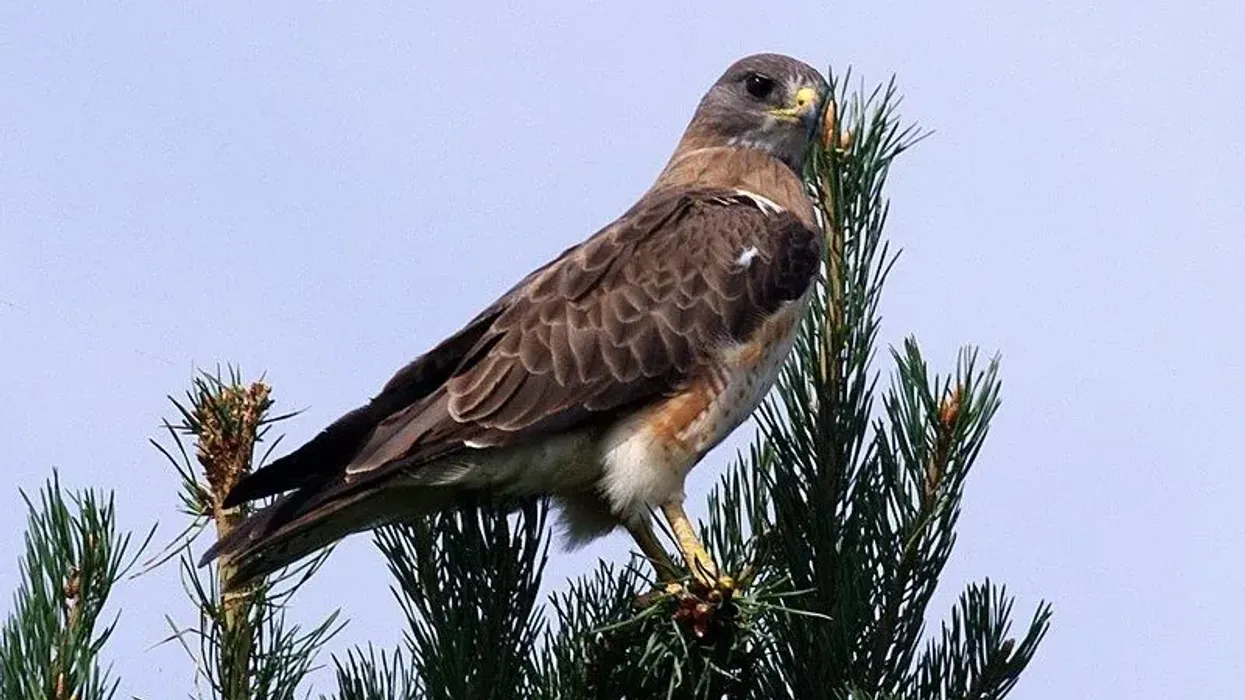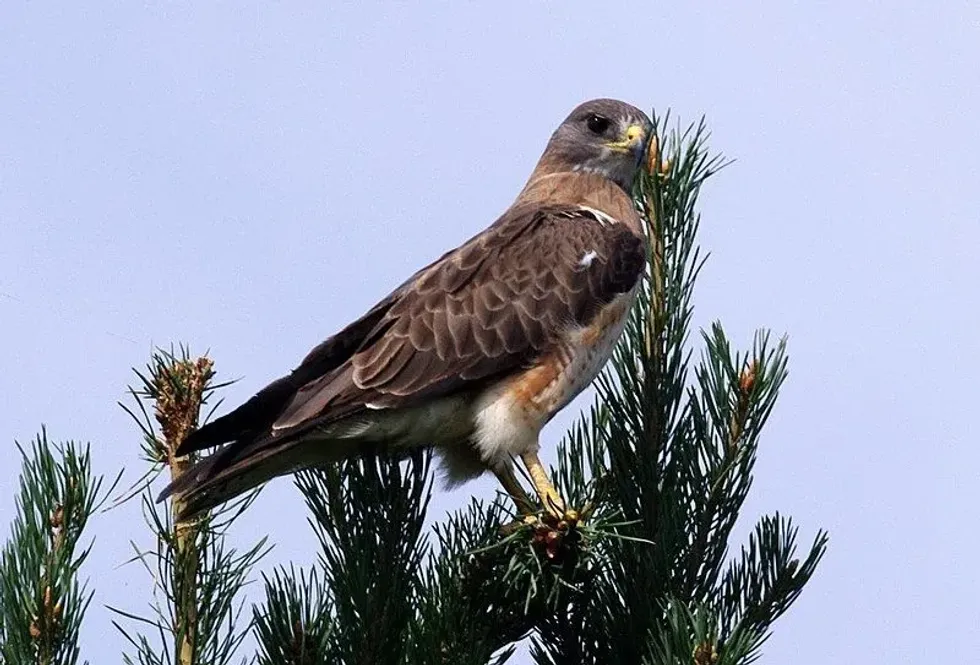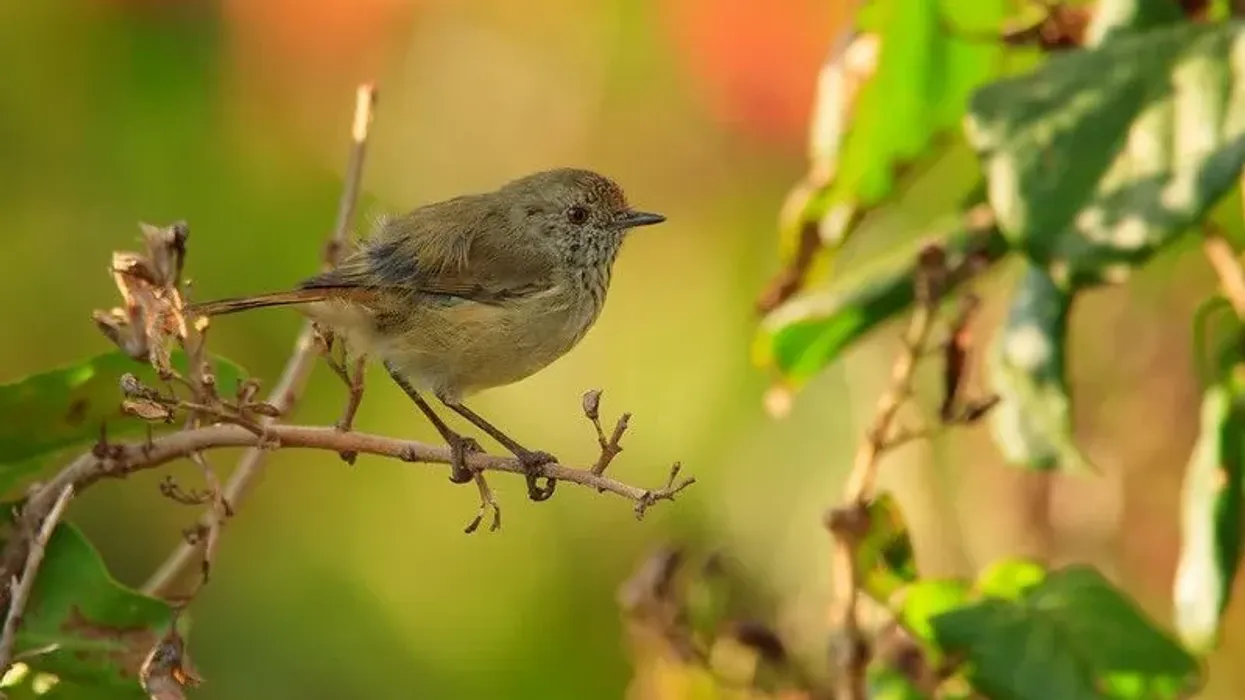Swainson's Hawk, Buteo swainsoni as it is scientifically known, belongs to the Accipitridae family. These are also known as locusts or grasshopper hawks as their diet mostly consists of these insects.
The Swainson's Hawk is found in deserts, grasslands and can also be seen on fence posts in open prairies and agricultural lands. These are mostly found in North America during summer, and during winters, it migrates to parts of South America or Argentina to their wintering grounds.
This species of hawk, Swainson's hawk, is known to be one of the longest travelers among North American birds.
The breeding season begins somewhere around or after March or April as it believed that somewhere around or two months before the breeding season, these hawks come to the nest site and males start building or constructing nests. Two to three eggs are laid and the incubation is done by females while the male brings the food.
The family stays together for some time until the chicks are ready to be independent. These birds migrate and nest in large flocks.
They tend to sit on a tree, bush, or pole waiting to attack prey like grasshoppers, locusts, and other small amphibians. These are medium-sized birds with slender, elongated wings.
Females tend to be slightly larger than males. There are mostly two variations of color, known as, dark morph and light morph.
The dark morph birds are dark brown in color with a light patch under their tail.
The light morph adults are different. Light morph birds are white on the underparts along with a dark reddish bib on the chest and a visible white patch on the face and throat and the tail is gray-brown in color.
The exists another variation of dark morph birds too. It is quite interesting to know about Swainson's Hawk, and if you're interested, read about the Cooper's Hawk and common nighthawk too.
Swainson's Hawk Interesting Facts
What type of animal is a Swainson's hawk?
Swainson's Hawks are birds.
What class of animal does a Swainson's hawk belong to?
Swainson's Hawks belong to the class Aves of birds.
How many Swainson's hawks are there in the world?
Estimation states that there are more than 800,000 hawks in the world.
Where does a Swainson's hawk live?
These hawks spend most of their year in the Western United States and in winter months, it migrates to Central America.
What is a Swainson's hawk's habitat?
These hawks prefer a grassland and desert-like habitat. These are found in open-range and prairie-type habitats too. These hawks also inhabit agricultural areas.
Who do Swainson's hawks live with?
These birds are known to form large flocks of up to 100 hawks during migration.
How long does a Swainson's hawk live?
These hawks are known to live for 16-19 years.
How do they reproduce?
These hawks arrive at the nesting sites in March or April. Around 7-15 days after they arrive, males start building or constructing nests on the ground, ledges, or in trees. These nests are made up of twigs and grasses.
Courtship includes circling or diving above potential nest sites. The rump and underwings are flashed and these birds call.
Copulation or breeding happens or takes place during the morning and evening on the dead limbs of the trees. The nests are isolated in trees, bushes, or riparian groves. Two to three eggs are laid, these eggs are elliptical in shape.
Incubation periods last for about 34-35 days. The female incubates and the male brings the food.
The young or the juveniles are fed mammals and the flight feathers begin to emerge when the young are 9-11 days old and they begin to leave the nest at 33-37 days and fledging occurs at about 38-46 days. These fledglings or the young ones are dependent on their parents for about four to five weeks.
These hawks have one brood a year.
What is their conservation status?
The conservation status of these hawks is Least Concern.
Swainson's Hawk Fun Facts
What do Swainson's hawks look like?
Swainson's Hawks are medium-sized hawks. These hawks have slender and elongated wings.
Females are slightly heavier and larger than males. There are mainly two color variations among the Swainson's Hawks.
Most of them are light morph while the dark morph is mostly found in the far west of the range. Light morph adults are white on the underparts along with a dark reddish bib on the chest and a visible white patch on the face and throat.
The tail is gray-brown in color with around six narrow bands and one wide subterminal band.
The upper parts are brown in color. Juveniles or young look similar but the dark areas are pale and light areas have darker mottling.
Dark morph hawks are dark brown in color but they have a light patch under the tail. There is another variant that has lighter underparts with reddish bars and the tails are similar to that of a light morph.

How cute are they?
These hawks are not considered to be cute by people. Rather, they are impressive birds.
How do they communicate?
These birds are known to use calls as a process to attract mates and other methods like visual, tactile, chemical, and acoustic to communicate with each other.
How big is a Swainson's hawk?
A Swainson's Hawk can weigh around 1.1-3.7 lb (0.5-1.7 kg) and their length ranges from 17-22 in (432-559 mm).
How fast can a Swainson's hawk fly?
The speed of their flight ranges from 22-28 mph.
How much does a Swainson's hawk weigh?
Swainson's Hawks can weigh around 1.1-3.7 lb (0.5-1.7 kg). The average weight for a male is around 1.8 lb (0.81 kg) and for a female is 2.5 lb (1.13 kg).
What are their male and female names of the species?
There are no specific names for the males and females of the species.
What would you call a baby Swainson's hawk?
There is no particular name for a baby Swainson's Hawk but the young of birds are in general called chicks.
What do they eat?
Swainson's Hawks are known to feed on anything that they can find. When it is in North America, its diet includes insects, small mammals, birds, and occasionally reptiles and amphibians. When these hawks migrate to Argentina to the wintering lands they feed mostly on crickets and grasshoppers.
Are they dangerous?
While some believe that these hawks usually do not harm humans, there have been a few instances where some of the species of hawks attacked humans.
Would they make a good pet?
Not much information is available about the Swainson's Hawks as pets but it is believed that these hawks are difficult to keep as pets as these are wild and migratory birds and long-distance migration happens during the winter season and maybe breeding season too.
Did you know...
Hawks are generally known all around the world and Swainson's Hawks were named after William Swainson, a British naturalist. Though, Swainson's Hawks were first described by Charles Bonaparte, French naturalist and ornithologist, and nephew of Emperor Napolean in 1838.
This species, the Swainson's Hawk or its immediate predecessor is the ancestor of the Galapagos hawk.
A group of hawks is known as a boil, knot, spiraling, stream, and tower of hawks.
Swainson's Hawks are some of the longest migrants of North American birds or raptors, the flocks travel a long distance from breeding grounds to South American pampas in Southern Brazil or Argentina can be around 7100 mi (11,400 km), and migration can last around two months.
The Swainson's Hawk has a high natal fidelity rate. Some of the predators of the young and eggs include ground squirrels. Even the chicks or the young of a Swainson's Hawk frequently kill and eat the youngest one of the nestlings. It may be because of the food unavailability but the exact reason is unknown.
Swainson's Hawks are also known as grasshoppers hawks, locust hawks as it is known to eat grasshoppers and locusts as and when they are available to them.
The juvenile red-tailed hawk and Swainson's Hawk look similar but the other ones have brown tails crossed with darker horizontal bars.
One of the best places to view Swainson's hawk is in the Snake River Birds of Prey National Conservation Area in Idaho. These can be sighted in mid-March, May, and June in the early morning and evening.
How will climate change reshape the range of the Swainson's Hawk?
The wildfires incinerate the habitat of Swainson's hawk and if it continues burning, the recovery will not happen. Spring heatwaves are a threat to the young hawk chicks in the nest.
It is believed that 11% of the range of these Swainson's Hawks will be lost and the range map will really differ in the future. While there will not only be a loss in the range there may be shifts, gain and stability observed too in the future.
Do hawks hunt in packs?
Swainson's Hawks hunt in packs. These hawks hunt using various methods. Some still-hunt, watching prey activity perching or sitting on a tree, bush, or pole. Others hunt by soaring over open grounds with wings held in a dihedral, using their vision for prey activity and occasionally courses low over the ground while hunting.
Here at Kidadl, we have carefully created lots of interesting family-friendly animal facts for everyone to discover! Learn more about some other birds including scrub jay or black-and-white warbler.
You can even occupy yourself at home by drawing one on our swainson's hawk coloring pages.










